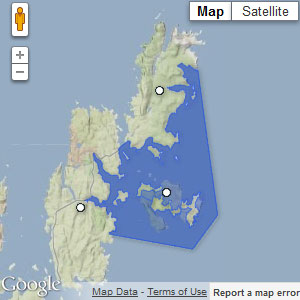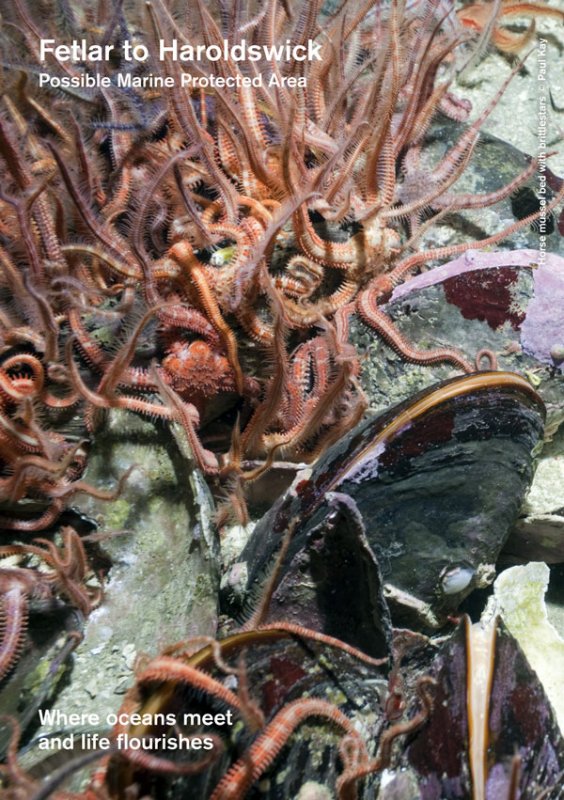 The MPA sits where the North Sea and the Atlantic Ocean meet, creating a turbulent mixing of waters and strong tides. The complex mosaic of islands, open coastline, and more sheltered bays and voes, results in a wide range of habitats that support a remarkably diverse array of animals and plants. [1]
The MPA sits where the North Sea and the Atlantic Ocean meet, creating a turbulent mixing of waters and strong tides. The complex mosaic of islands, open coastline, and more sheltered bays and voes, results in a wide range of habitats that support a remarkably diverse array of animals and plants. [1]
The Fetlar to Haroldswick MPA was designated in 2016, and a consultation on proposed management measures for this site is expected later this year.
The site has been designated to conserve the biodiversity and geodiveristy features:
Biodiversity:
- black guillemot
- circalittoral sand and coarse sediment communities
- horse mussel beds
- kelp and seaweed communities on sublittoral sediment
- maerl beds
- shallow tide-swept coarse sands with burrowing bivalves
Geodiversity: marine geomorphology of the Scottish shelf seabed
For more information see: SNH website.
Read our response to the 2013 site consultation here:
Save Scottish Seas campaign members have assessed the Scottish Government’s MPA proposal for this site as part of its consultation response.
LINK supports the designation of the Fetlar to Haroldswick possible Nature Conservation MPA for the protection of biodiversity features: black guillemot; circalittoral sand and coarse sediment communities; horse mussel beds; kelp and seaweed communities on sublittoral sediments; maerl beds; and shallow tide-swept coarse sands with burrowing bivalves; and geodiversity features: marine geomorphology of the Scottish shelf seabed. The boundary of the site is supported.
The management options paper notes that ‘maerl beds and horse mussel beds are considered highly sensitive to certain pressures associated with finfish farming’ and ‘any impacts to the horse mussel beds, maerl beds, and kelp and seaweed communities on sublittoral sediment will have already occurred’. On this basis, and following the MPA guidelines, the conservation objective for these features should be set to ‘recover’ to reverse some of these historic impacts.
We support the conservation objectives of conserve for the other features.Read the rest of our response here:
Management Options:
Management should ensure no new finfish and shellfish aquaculture sites are developed within the possible MPA and, where there is risk of damage to protected features, existing facilities should be relocated. Towed/active gear should be removed from areas with the following features to ensure their protection and enable their recovery: maerl beds, horsemussel beds , shallow tide-swept coarse sands with burrowing bivalves, kelp and seaweed communities on sublittoral sediment, shallow tide-swept coarse sands and circalittoral sand and coarse sediment communities. The existing scallop dredging restrictions are welcome but in line with the above preference should be extended to cover the known extent of the features listed with a buffer area to enable their recovery.
LINK strongly supports the management measures for black guillemot, to reduce or avoid the spread of mammalian predators. Black guillemot are known to feed in kelp beds and while current threats may be small this site should also be considered in the parallel draft seaweed policy statement consultation, particularly with regards to guidance developed for the harvest of wild seaweed.
In the absence of detailed information relating to the impacts of aquaculture on proposed protected features within an MPA it is imperative that the precautionary approach be applied. Discussions with finfish farming interests cannot be used as a proxy for specific, detailed information and where doubt exists management measures must be precautionary.Socioeconomic Assessment:
We note that displacement of fishing activity from the Fetlar to Haroldswick possible MPA is estimated to have zero impact on loss of landings, therefore further restricting towed/active gear to allow greater scope for feature recovery is unlikely to have significant socio-economic impact. The potential value of the Fetlar to Haroldswick possible MPA to divers and anglers has been estimated at £5.7million to £12million based on willingness-to-pay measures (Kenter et al., 2013) . Kenter et al. also found important emotional and well-being benefits associated with the Fetlar to Haroldswick possible MPA, with divers and anglers responding to questionnaire scoring >4 (out of a maximum score of 5) for engagement, therapeutic, spiritual and transformative wellbeing indicator values. LINK supports the designation of the Fetlar to Haroldswick possible Nature Conservation.
Where present, kelp habitats ought also to be protected in this pMPA to support wider ecosystem function, including black guillemot feeding.Check out the official documents relating to the possible Fetlar to Haroldswick MPA on the Scottish Natural Heritage website.

